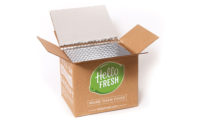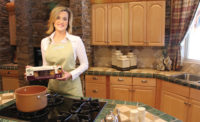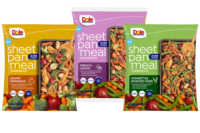Today's Meal Kits Give Ready-Made Meals a New Twist
Today’s Meal Kits Give Ready-Made Meals a New Twist
By William Makely
About five years ago, Todd Simon, co-owner of Omaha Steaks, came to the conclusion that, in the modern rushing world, his customers might be looking for quality prepared meals in addition to a good steak. That’s when Simon launched Á la Zing, a brand of quality frozen meals that include what have come to be known as “meal kits”—meals that, while they come in various stages of preparation, leave some of the cooking to the consumer.
Most of the kits require some work, even if it is as simple as mixing a dried sauce with meat and pouring it all into a baking dish. As the Christian Science Monitor observed in 2003, “Consumers can’t just stick the kits in the oven—and that’s part of the allure.” The writer was describing the rather simple, $5 dinner kits available in many grocery stores. But today’s kits can cost as much as $35 and up for a gourmet dinner. Whether it stems from assuaging guilt about not having the time to cook a “real” meal for one’s family, from a desire for a share of ownership in the result, or just from the relaxation that can come from a brief stint as a cook, the same appeal still applies.
Kits for the whole spectrum
Today’s kits cover the range of participation levels, from little to not-so-little cooking input. None involve time-consuming effort—which is the point.
Banquet Crock-Pot Classics, for instance, contain the ingredients needed for a slow-cooked meal—tender meats, fresh vegetables, hearty potatoes and perfectly seasoned sauces—and are ready to cook with less than five minutes of preparation, eliminating the need for cutting and chopping meats and vegetables or combining multiple ingredients for sauces. Everything goes into the slow cooker, which works its magic while the “cook” is at work.
Wornick’s Homestyle Express Asian Style Selections include rice and meats in separate microwaveable pouches. The cook pops these into the microwave for a few minutes then combines them to create a meal for four. Other Asian options include Annie Chun’s Meal Kits. Consumers boil the noodles as directed, add sauce, then toss in their own sautéed vegetables, tofu or chicken, and they have a meal in less than 10 minutes. Choices include dishes like chicken chow mein with snow peas and cashews, Chinese New Year Long Life stir-fry, and chow mein with garlic black bean sauce.
Á la Zing’s family meals range from English pub-style fish and chips to a pot roast with vegetables. Some meals are cooked in separate pots then combined; others are heated as a unit. All are quick to prepare. And many are low-carb.
Local flavor
A completely separate market exists on the local level, where kitchens—some connected with restaurants and caterers and others on their own—prepare individual meal kits for local delivery and use online ordering and electronic payment systems.
Fresh Gourmet to Go in Phoenix is one such entity, offering meal kits with all the freshly prepared ingredients and simple step-by-step directions for consumers to prepare a gourmet meal in 30 minutes or less. Meals include items like pork medallions with carrot-ginger sauce and salmon in miso broth with Asian vegetables.
Branding and packaging
Meal kits operate in a diverse marketplace where brands and packaging vary widely.
Fresh Gourmet to Go, a relatively new business, uses very basic packaging—generic blank iso-thermal bags, which contain a variety of rigid plastic containers that are numbered to correspond to references on recipe cards attached to the outer bag.
Á la Zing, at the other extreme, packages meal kits in elegant outer cartons conceived by design firm Fitch and executed by in-house graphic artists. Cartons carry the message, “We provide the meals, you provide the memories,” emphasizing the quality of the “special” meal inside.
Between the two extremes are the majority of kits sold in retail environments. Whereas the delivery items rely on online graphics to attract orders, these packages, like all others, are charged with attracting shoppers and “closing” the sale.
Banquet does so by tying the surface graphics of its Crock-Pot Classics to the Rival Crock-Pot brand, which is shown on the front of the package, a bright-red standup pouch that stands out in the freezer case.
“The immediate name recognition of the Banquet brand and Rival Crock-Pot brand lets the consumer know he can trust his family’s appetite to this innovative new product,” says John Hanson, vice president, marketing for Banquet. “Crock-Pot is the leading brand in slow-cooking, and Banquet is a name consumers count on.”
To design its pouches, Wornick worked with Wilker Design to brand the packaging with the Homestyle Express logo—a line it introduced in 2000 with a collection of single-serve bowls. The addition of a red starburst relays the message that these new 18-ounce pouches are intended to serve four.
This shelf-stable line was introduced in Wal-Mart supercenters in September 2004 and is growing steadily into other channels. According to Paul Dupont, director of sales and marketing for Wornick, the rice package has proved popular in convenience stores, where its pouch stands out well on the crowded shelves.
Annie Chun’s meal kit carton also stands out on the shelf with a prominent full-color photo of the finished meal on the front face of the package. It is the one product among our examples that is sold at retail—in limited, upscale venues—and also online.
The meal kit marketing challenge
Regardless of the sales channel, the challenge facing most meal kit marketers is to project the message that the contents are somewhat, but not completely, prepared for heating and serving—and that the feature is (as Martha Stewart might say) a “good thing.”
Consumers are more time-starved than ever and research indicates that prepared meals (along with takeout and fast food) are rising in demand, but the actual experience of engaging in food preparation will likely continue to be a source of satisfaction, particularly for couples and families looking to share a meal at the end of the day.
It is not surprising, therefore, that meal kits are almost universally dinner options and that they are increasingly for multiple diners They hit a sweet note with consumers who want to spend less time cooking but also to make each meal their own, by having a personal investment in its preparation. BP
The author, William Makely, has written extensively on packaging and technology. Contact him at billmakely@aol.com.
Where to go for more information...
Package design. At Wilker Design, contact Mary Beth Wilker at 513.351.3333 or marybeth@wilkerdesign.com
Brand management. At Á la Zing, contact Ann Colony at 402.597.3000 or annc@omahasteak.com.
Package design. At Fitch: RPA, contact Carey Stumpf at 614.885.3453 or info@rpaworldwide.com.
Looking for a reprint of this article?
From high-res PDFs to custom plaques, order your copy today!








